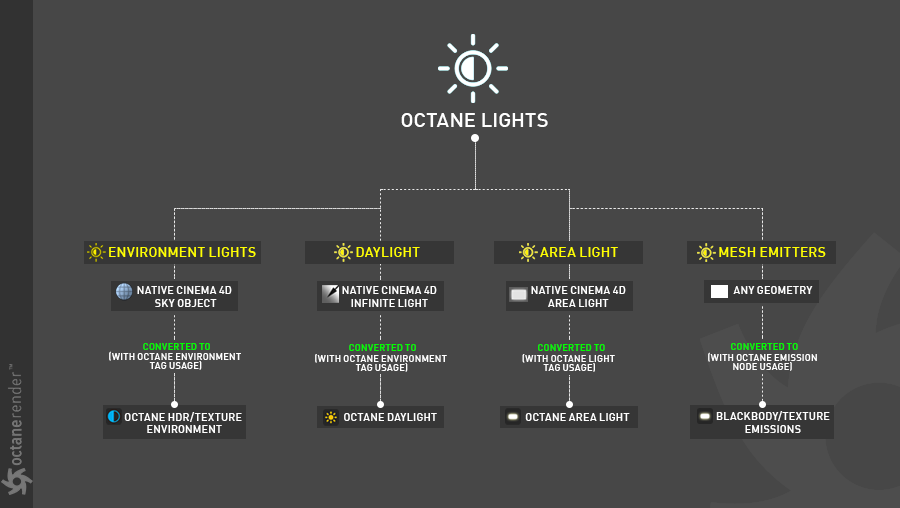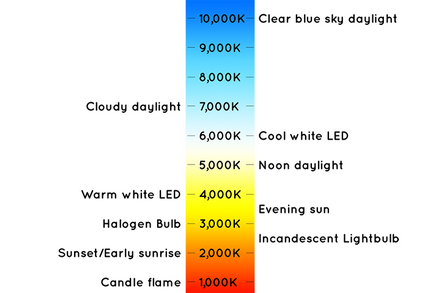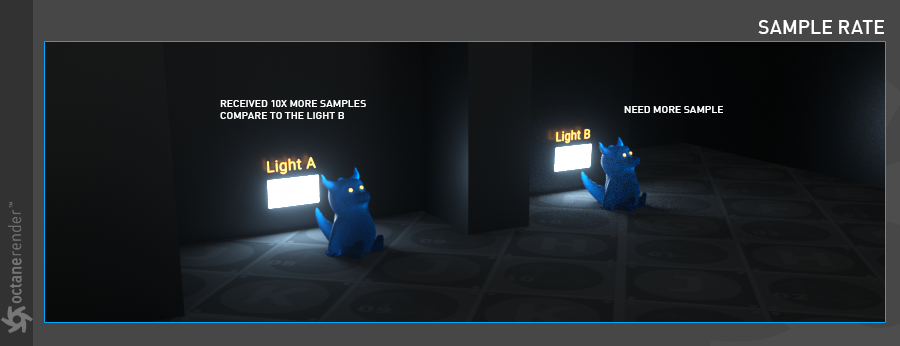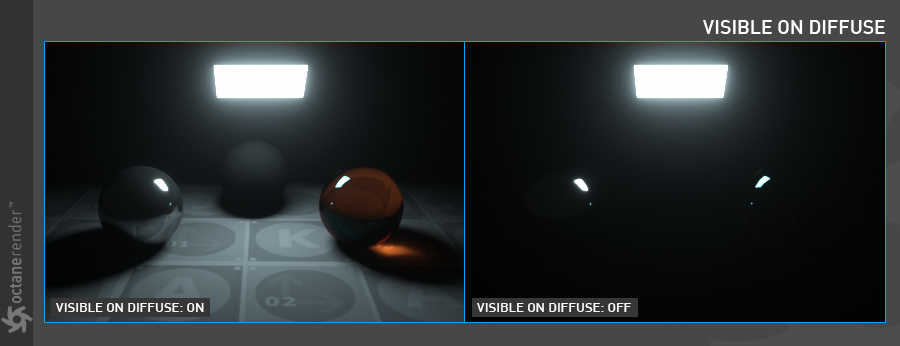Octane Light Tag Introduction
The Octane Light tag is created by adding a light in OctaneRender®, which will then add a “Light Tag” to the new light at the same time. All of the settings related to the light, outside of the Cinema 4D-supplied attributes for the light, reside in the Octane Light Tag. The illustration below shows how lights are created and organized in OctaneRender.
The Light Tag consists of four main tabs: Basic, Main, Light Settings and Visibility. The Basic tab is the classic Cinema 4D tab; the other tabs are explained in the following sections.

GENERAL SETTINGS OF THE LIGHT TAG
These settings apply to all light types supported by OctaneRender®. The image below illustrates the components of the Octane Light tag, as seen in the Attribute Manager.

MAIN GROUP
The Main group contains settings to choose the Light type, enable the light and to choose the type of emission of the light source.
**
NORMAL AND IES LIGHT ICONS
Select the icon that represents the light type desired. When you press the IES icon, you can start using special light data with the “ies” file extension. This topic is discussed in detail in “IES Lights“.
ENABLE
Enable/Disable the use of the light.
TYPE
Choose between Blackbody and Texture emission for the light.
LIGHT SETTINGS GROUP
The Light Settings group contains most of the settings needed to control the characteristics of the light.
POWER
The Power attribute value represents light energy in Watts. To get a realistic render output, enter real world light wattage values into the power setting, representing the proper values for the desired light source. For example, standard bulb wattage typically has a range of between 25 to100 watts and radiates a brightness of about 250-1600 Lumens. In this same range of lumens, Halogen bulbs are 18-72 watts for the same brightness as standard bulb. LED bulbs fall into the 4-20-watt range for standard bulb brightness. Of course, any value can be used, but if realistic results are desired, it is best to stick with known wattage values.

TEMPERATURE
Adjust the emission color temperature of the light in degrees Kelvin. The following chart shows the visible spectrum of light mapped to the Kelvin scale:

This scale suffices in the case of typical lights commercially available for home or business use. However, there are plenty of other situations where lights are actually colored in different values (such as cinematic gels that are used to color lights on movie shoots.) This can be easily done:
1- Define an Octane “RGB Spectrum” or “Gaussian Spectrum” in the texture channel (Gaussian Spectrum is recommended for better quality and range). The color usage in Octane is wavelength based, and, as a result, all of the RGB inputs that in Octane are converted to wavelength. RGB conversion is not perfect, and at higher light intensities, RGB colors are clipped, and you may see colors other than desired. The Gaussian spectrum node does not have this issue.
2- In the Settings window, you can check “Use Light Color” slightly below. In this case, you can set the color of the Cinema 4D’s classic light color.
TEXTURE
This option can be used to color the light images, other texture nodes (RGB Spectrum, Gaussian, etc.) and go beyond basic color temperature as offered by Kelvin. The options are almost limitless, but beware of noise; some HDR image sources may add quite a bit of it, requiring an increase in Light samples. For details see Texture Emission.
DISTRIBUTION
This option is used to define the pattern of the light cast, and is useful for creating “gobo Lights” and “IES Lights”, for example. You can also create various light patterns using a grayscale or alpha image. In the example below, various light patterns are created using alpha images in the Distribution channel. Once you have defined the alpha image on the Distribution channel, you can make adjustments on the texture by adding Transform and Projection (using the Octane Image Texture), explained in the “UsingTextures“ section. Also remember to make the “Texture Projection” option “perspective” from Projection (when you rotate the light, it can be rotated on your texture). For IES lights, just connect the “.ies” file into Distribution pin via an Image Texture node.

SURFACE BRIGHTNESS
This option increases or decreases the brightness value of the light according to the size of the Emitter Object. Select “On“ to see that brightness changes when the Emitter object is scaled. Select “Off“ to allow brightness to remain constant, regardless of the scale of your Emitter Object.

DOUBLE SIDED
This option is used to emit both sides of the Emitter Object. Default is “Off“.

NORMALIZE
Normalize will keep the Luminance value constant as the temperature values of the emission change. When it is off, the “luminance” level will change as the temperature changes. According to this, in the low temperature parts of the Visible Spectrum (orange, red), the light brightness will decrease, and at the higher points (white, blue) the light brightness will increase. Default is “On“.

SAMPLE RATE
The sample rate determines how many samples will be used in the shading of the light being cast. In some cases, there may be more than one light in your scene, and some of them may create noise in a certain area. In such cases you can reduce noise by defining more samples for a given light. However, you may need to set the sample rate of other lights when doing this, because this option works as a “ratio”. You can think of blackbody emissions on the scene as “sample weighting”. In the example you see in the picture below, “Light A” has 10x more samples than “Light B”. The default value of 1 works in most scenarios. It is recommended to keep the default value unless you use different lights and noisy situations.

VISIBLE ON DIFFUSE
This option enables the light source to be visible on diffuse surfaces (defaults to ON), enabling or disabling light sources from casting illumination or shadows on diffuse objects. Disabling this option will disable emission, i.e., it won’t be visible in diffuse reflections, but still be fully visible in specular reflections. It will also be excluded from the direct light calculation.

VISIBLE ON SPECULAR
This option will enable the light source to be visible on specular surfaces (defaults to ON). This allows users to hide emitters on specular reflections/refractions only.

CAST SHADOWS
This option enables shadows to be cast from the light source, and provides the means to disable direct light shadows for mesh emitters (defaults to ON).

TRANSPARENT EMISSION
This option determines whether or not the emission power should be scaled with opacity (defaults to ON). This is useful if you want to control the light in your scene without your emitters being directly visible. But there are cases when transparent emitters should not emit light. Consider the following example: if you define any alpha image on the Opacity channel of this object, the reflection will not be correct. However, if you turn off “Transparent Emission”, the reflection will look correct.

USE LIGHT COLOR
This option will use the color of the light from the “General” tab in the light options of Cinema 4D.

OPACITY
This option is to define the opacity value in Blackbody Emission.
LIGHT PASS ID
This option will set the Light ID for the specific light (lights with the same ID will be contained in the same light pass/AOV). The light pass ID is used for light linking and excluding, as discussed here.

VISIBILITY SETTINGS GROUP
The Visibility Settings group determines whether or not the light will be visible to the camera (but still cast light), visible to shadows, or completely invisible.
CAMERA VISIBILITY
With this option you can control whether the light will be seen by the camera. When “on”, the light object is rendered. When “off”, the object itself is not rendered, but illumination other features remain the same.

SHADOW VISIBILITY
This option works for normal polygon objects rather than light objects. For a detailed description, please refer to the Octane Object Tag section.
GENERAL VISIBILITY
This option is basically a global combination of the Camera visibility and Shadow visibility options, and honors the Transparent Emission setting. Unlike the Camera and Shadow visibility options, General Visibility offers a slider, to gradually decrease these effects.

